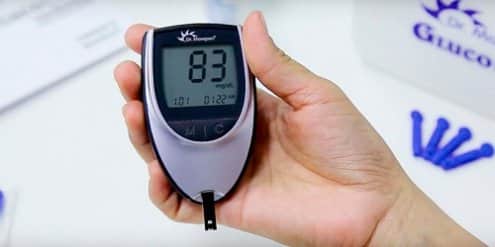What is a glucometer (blood glucose meter)?
A diabetic blood glucose meter is a small medical device that helps diabetic patients to measure their blood sugar levels right from home. Monitoring blood sugar levels is an important part of controlling diabetes. A glucometer comes as part of the home glucose monitoring kit that can be bought from a drugstore. Both type 1 and type 2 diabetic patients are supposed to monitor their blood glucose level to prevent it from reaching dangerous levels. Your doctor will tell you how many times per day, you are supposed to check your blood sugar levels. Once you have tested your blood glucose levels, you should share your results with your doctor. This will help them determine if there is need to adjust your dosage. Your blood sugar results can also help your doctor understand how exercise and diet affects your blood glucose levels.
Today, some advanced glucose meters models have apps, which you can use to send blood sugar results to your doctor. Therefore, you can send real-time updates on how you are fairing with your diabetes treatment. This has proven to be convenient for most people with diabetes in managing their condition. Other advanced glucometers allow you to track the food you eat and include notes of your exercise. This information helps you to understand how a jog can affect your blood glucose level. An example of a high-tech blood glucose meters include Telcare wireless glucose meter.
How to use a glucometer
It is important you wash and dry your hands before you start to use a glucometer. Also, make sure you carefully follow the instructions on how to operate your glucometer. This may include where to insert the disposable test strip, how to read the results, and how much of a blood sample is needed for testing. In case you don’t understand anything, you should call your doctor for clarifications, before you start to use the device. Generally, you should wash your hands with soap and hot water. Clean the finger you want to prick using rubbing alcohol and let it dry. The next step is to insert the test strip into the glucometer. Your glucose meter will then prompt you to place a blood sample on the test strip. Use a lancet to prick your finger, so as to draw a blood sample. Place the blood sample on the test strip and wait for the results. Depending on the device, your results can take between 5 to 30 seconds before it appears. You will hear a beeping sound which means your results are ready for reading. The blood test meter will display your blood sugar levels in mmol/l or mg/dL.
How does a glucose meter work?
When you place blood on the disposable test strip and insert it into a glucose measuring device, it reacts with a chemical known as oxidase. This reaction produces gluconic acid from the blood glucose. The test strip also has electrical terminals that allows the glucometer to measure a current. The current will vary depending on level gluconic acid, which the glucose meter uses to calculate blood sugar levels.
Disclaimer: Please note that the contents of this community article are strictly for informational purposes and should not be considered as medical advice. This article, and other community articles, are not written or reviewed for medical validity by Canadian Insulin or its staff. All views and opinions expressed by the contributing authors are not endorsed by Canadian Insulin. Always consult a medical professional for medical advice, diagnosis, and treatment.


